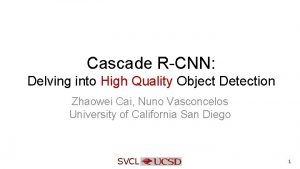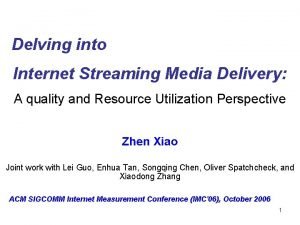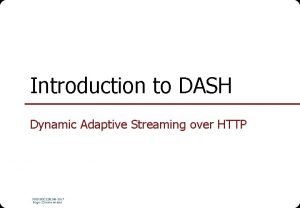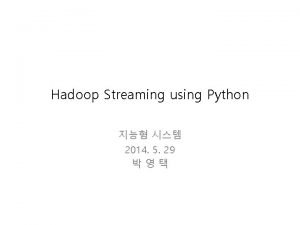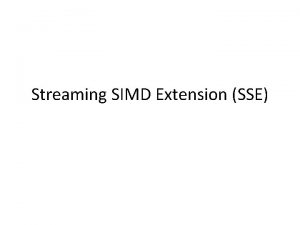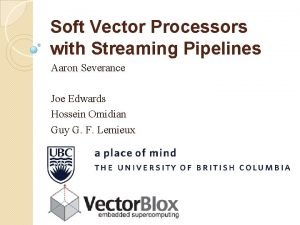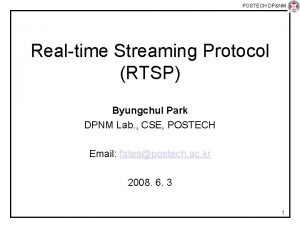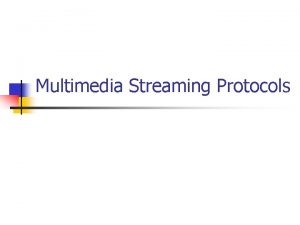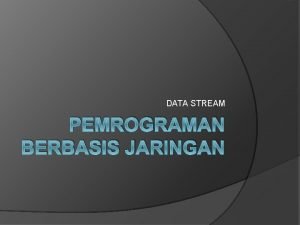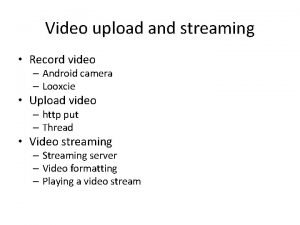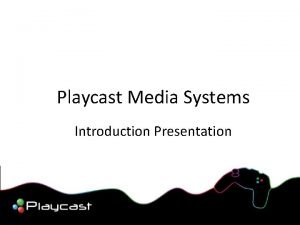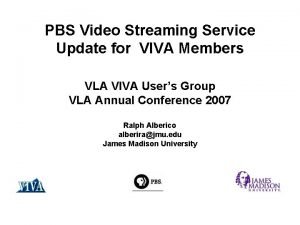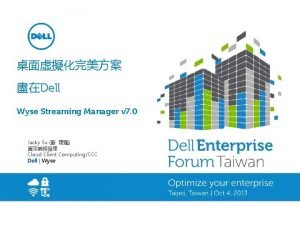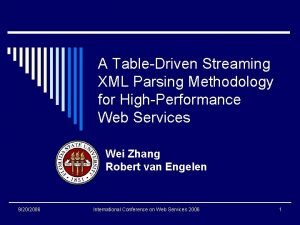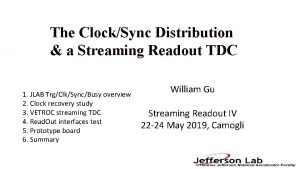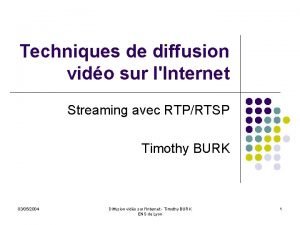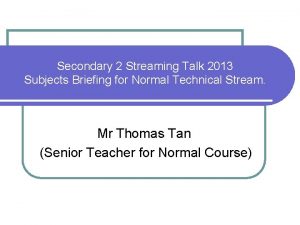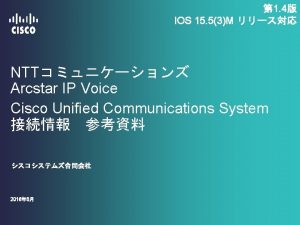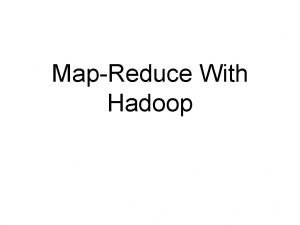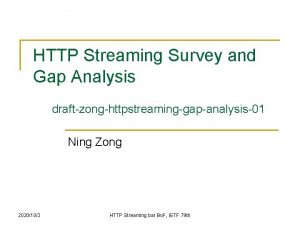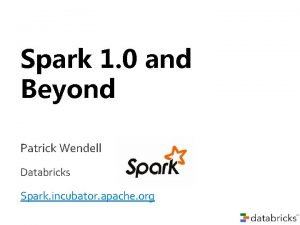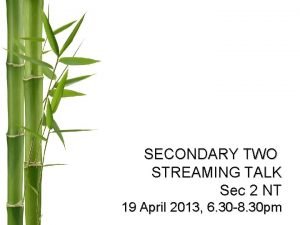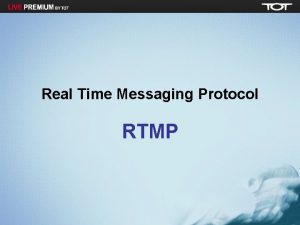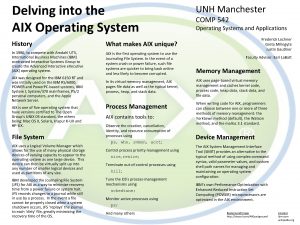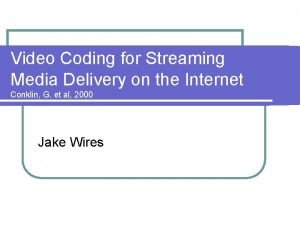Delving into Internet Streaming Media Delivery A quality

















































- Slides: 49

Delving into Internet Streaming Media Delivery: A quality and Resource Utilization Perspective Written by: Lei Guo, Enhua Tan, Songqing Chen, Zhen Xiao, Oliver Spatscheck, Xiaodong Zhang Presented by: Harris C. C. Sun Dicky Kwok

Multimedia: Downloading Web browser HTTP Web Server Long start-up latency Potential waste of traffic Media player

Multimedia: Pseudo Streaming Web browser Web Server Media player

Multimedia: Streaming Web browser HTTP Web Server RTSP/MMS/HTTP RTP/RTCP Media player Streaming Server

Streaming Media • Merits – – Thousands of concurrent streams Flexible response to network congestion Efficient bandwidth utilization High quality to end users • Challenges – Lack of Qo. S on the Internet – Diverse network connection of users – Prolonged startup latency • Research and techniques – Effective utilization of server and Internet resources – Mechanism of streaming media delivery • • Protocol rollover, Fast Streaming, MBR and rate adaptation

Motivation • Modern streaming techniques concentrated on the techniques of – media access pattern and – user behaviors to improve streaming performance. • Few focused on – the improvement of techniques for quality streaming delivery and – the effective utilization of media resource.

Objective and approach • Understand modern streaming techniques – The delivery quality and resource utilization • Collect a large streaming media workload – From thousands of home users and business users Hosted by a large ISP (Gigascope) – RTSP, RTP/RTCP, MMS, RDT packet headers instead of server logs • Analyze commonly used streaming techniques – Fast Streaming – Protocol rollover – MBR encoding and rate adaptation • Propose a coordinated streaming mechanism – Effectively coordinate the merits from caching and rate adaptation

• Trace Collection and processing Methodology • Traffic Overview • Fast Streaming • Rate Adaptation • Protocol Rollover • Coordinated Streaming • Summary

Trace Collection and processing methodology • Collect streaming packet • Capture all TCP packet within ports 554 -555, 7070 -7071 9070 and 1755 • Keywords matching to collect RTSP and MMS packet • Group TCP packet by IP addresses, port, TCP SYN/FIN/RST flag • Extract streaming command from each request • Identify media data and control packet

• Trace Collection and processing Methodology • Traffic Overview • Fast Streaming • Rate Adaptation • Protocol Rollover • Coordinated Streaming • Summary

Traffic Overview • User communities – Home users in a cable network – Business users hosted by a big ISP – Have different access patterns • Media hosting services – Self-hosting – Third-party hosting

Traffic Overview • Access Pattern – – Business users access more audio than home users Business users tend to access longer audio/video files Business users tend to play audio/video longer Business users tend to access live audio/video longer • Media Hosting Service – Self-hosting: yahoo. com, aol. com, wbr. com – Third-party hosting: akamai. com. Lime. Light Networks, fplive. net

• Trace Collection and processing Methodology • Traffic Overview • Fast Streaming • Rate Adaptation • Protocol Rollover • Coordinated Streaming • Summary

Fast streaming • A combination of techniques – Fast start Transmits data as fast as possible until the play-out buffer is filled. – Fast cache Streams media data up to 5 times the encoding rate – Fast recovery – Fast reconnect Rare in workload traffic, not include them in study

Fast streaming • A combination of techniques – Fast start – Fast cache – Fast recovery – Fast reconnect 40% 60%

Smooth bandwidth flucation • Rebuffering ratio Rebuffer ratio = rebuffer time / play time • Less rebuffering ratio then normal TCP streaming

Production of extra traffic • Oversupplies media to the client when client early terminate the media service • Over-supplies about 54. 8% of media data on average, while TCP streaming over-supplies about 4. 8% data only. Normal TCP: < 5% oversupplied Fast Cache: > 55% oversupplied

Server Response time • Longer time to be served • 43% of request longer than 0. 1 s running on Fast Cache while only 9% of request longer than 0. 1 s in TCP streaming • Fast cache is statistically longer than that on servers not running Fast Cache Third party media service > 40% 20 ms Self-hosting media service

Server load • 3. 6 times higher server load than normal TCP streaming Server log 1 X 4 X CPU

Effectiveness ? • Throughput (rebuffer ratio) of Fast Streaming similar to that of TCP streaming – Only feasible when bandwidth is large enough – Less possibility of congestion in this case Encoding rate: 200 – 320 K bps Bandwidth: > 500 Kbps Fast Cache: not resource-efficient

• Trace Collection and processing Methodology • Traffic Overview • Fast Streaming • Rate Adaptation • Protocol Rollover • Coordinated Streaming • Summary

Challenges of Streaming • Bandwidth fluctuation – Quality of media streaming may significantly degrade • Connection of speed varies – From dial-up to cable • Prolonged startup latency

Challenges of Streaming • Under the situation of bandwidth fluctuation, a technique of Rate Adaptation is widely used by media players • The basic concept is simple. – modify the stream bit rate to adapt the various bandwidth – Resume when bandwidth recovers – Never higher than original bit rate

Rate Adaptation • In order to adapt to bandwidth fluctuation, major media services support three kinds of techniques for rate adaptation. – Stream switch (also known as Intelligent Streaming in WM and Sure. Stream in Real. Network) – Stream thinning – Video Cancellation

Rate Adaptation • Stream Switch – Multiple bit rates (MBR) must be used – According to the statistic of the paper, MBR encoding technique is widely used in media authoring

MBR Encoding on-demand audio live audio stream in video objects video stream in video objects 42% on-demand video are MBR encoded with at least two video stream The maximum numbers of streaming is 20

How it works DESCRIBE ion t p i scr de PLAY Setup Streaming content

How it works • When bandwidth drops Request to switch to lower rate stream • WM sends command with a body specifying current stream and new stream • REAL sends UNSUBSCRIBE to cancel the current stream, and SUBSCRIBE to switch to new stream

How it works • During transmission, if the bandwidth decreases, the server automatically detects the change and switches to a stream with a lower bit rate. If bandwidth improves, the server switches to a stream with a higher bit rate, but never higher than the original bit rate. (from Microsoft page)

Problem Occurs • After extracting and analyzing information from RTSP/MMS commands, switch latency occurs • Switch latency occurs as the freezing duration between old stream and new stream • User has to wait for re-buffering • Low quality duration appears

Problem Occurs • 30%~40% of stream switches have latency greater than 3 seconds • 10%~20% of stream switches have latency greater than 5 seconds • 60% of sessions have low quality duration less than 30 seconds • 85% are shorter than 40 seconds • Non-trivial for end users

Stream Thinning • Similar to stream switch • If the bandwidth can no longer support the streaming video, the image quality will be degraded in order to avoid buffering • Thinning interval is defined as the interval between two consecutive stream thinning events

Stream Thinning • 70% of the thinning duration are shorter than 30 seconds • 70% in the home users and 82% in the business users, the thinning intervals are longer than 30 seconds

Video Cancellation • When the bandwidth is too low to transmit the key frame of video stream, the client may send a TEARDOWN command to cancel the video streaming • After that, the server maintains the continuous audio steam only • If the bandwidth increases, the client may set up and request the video streaming again

• Trace Collection and processing Methodology • Traffic Overview • Fast Streaming • Rate Adaptation • Protocol Rollover • Coordinated Streaming • Summary

Protocol Rollover • Streaming protocol: UDP, TCP, HTTP Delivery over UDP X Delivery over TCP X HTTP • Due the wide deployment of NAT routers/firewalls in both home and business users, protocol rollover results in great affect of startup latency

Protocol Rollover CASE 1: SETUP (UDP) Return UDP CASE 2: SETUP (UDP) Return TCP CASE 3: SETUP (UDP) Return UDP

Protocol Rollover • In the collected data, if protocol rollover occurs, it tried to establish UDP from 1 to 3 times before switching to TCP • Protocol rollover takes non-trivial time, increase the startup latency • The default protocol in client is usually UDP • However, some interesting results are revealed by the data.

Protocol Rollover • In home user workload, only 7. 37% of streaming session trying UDP first then switching to TCP. • In business user workload, only 7. 95% in the streaming session. • These imply that TCP is directly used without protocol rollover in most streaming. • What happened?

Protocol Selection & Rollover Avoidance • The phenomenon can be explained as following: • Windows streaming service allows the specification of protocol in URL modifier at client side or server side – Content provider: use URL modifier to specify protocol in the meta file – rtspt: //xxx. com: /xxx. wmv (TCP) >70% – rtspu: //xxx. com: /xxx. wmv (UDP) rarely • After extracting URL modifier, 70% of streaming session is specified as TCP

Protocol Selection & Rollover Avoidance • The conjecture is: – Content providers are aware of NAT/firewalls – Understand UDP is mostly shielded by clients – They actively use TCP to avoid shielding or protocol rollover – Even if UDP is supported, the streaming is delivered over TCP directly

Proof • Further investigate the NAT usage with MMS • Different from RTSP, clients report local IP address to server • Most users report private IPs • Indicate that clients access internet through NAT

• Trace Collection and processing Methodology • Traffic Overview • Fast Streaming • Rate Adaptation • Protocol Rollover • Coordinated Streaming • Summary

Coordinating caching and rate adaptation • Fast Cache: aggressively buffer data in advance – Over-utilize CPU and bandwidth resources – Neither performance effective nor cost-efficient • Rate adaptation: conservatively switch to lower bit rate stream – Switch handoff latency • Coordinated Streaming high rate stream low rate stream Lower bound Prevent switch latency Upper bound Prevent aggressive buffering

Results • Rebuffering ratio is close to zero • Reduces 77% over-supplied traffic produced by Fast Cache, though still not as good as TCP streaming • Switch handoff latency is nearly zero

• Trace Collection and processing Methodology • Traffic Overview • Fast Streaming • Rate Adaptation • Protocol Rollover • Coordinated Streaming • Summary

What We Learn and What We Think • This paper mainly aim at investigating the current streaming technique used by media players • Most people enjoy video streaming but seldom know theory behind • Modern streaming services over-utilize CPU and bandwidth resource • Coordinated Streaming is suggested • Ideal theory but not sure if it works in reality.

What We Learn and What We Think • More research papers are written by same group of people • More study are needed

Thank You!
 Cascade r cnn
Cascade r cnn Streaming media delivery
Streaming media delivery Https://methodology.accenture.com
Https://methodology.accenture.com Internet delivery methods
Internet delivery methods Quality cost delivery presentation
Quality cost delivery presentation Delivery quality assurance
Delivery quality assurance What is internet
What is internet Ball setting and streaming
Ball setting and streaming Twitter sentiment analysis using spark streaming and kafka
Twitter sentiment analysis using spark streaming and kafka The prime of miss jean brodie streaming
The prime of miss jean brodie streaming Dash dynamic adaptive streaming over http
Dash dynamic adaptive streaming over http Xxnx ica
Xxnx ica Hadoop streaming python
Hadoop streaming python United discovery streaming
United discovery streaming Network streaming telemetry
Network streaming telemetry Simd
Simd What is streaming potential
What is streaming potential Severance streaming
Severance streaming Realtime streaming protocol
Realtime streaming protocol Multimedia streaming protocols
Multimedia streaming protocols Ll-hls
Ll-hls Stream adalah
Stream adalah Record streaming video android
Record streaming video android Recycle
Recycle Subject combination sec 3
Subject combination sec 3 Osama streaming
Osama streaming Mac mishmarot
Mac mishmarot Qtss timetable
Qtss timetable Oedipe roi streaming
Oedipe roi streaming Lola streaming
Lola streaming Wyse streaming manager
Wyse streaming manager Streaming xml parser
Streaming xml parser Cytoplasmic streaming
Cytoplasmic streaming Clocksync
Clocksync Streaming
Streaming Secondary 2 streaming
Secondary 2 streaming Https://ipvoice-portal.ntt.com/login/?next=/
Https://ipvoice-portal.ntt.com/login/?next=/ Hadoop assignment help
Hadoop assignment help Streaming architecture patterns
Streaming architecture patterns Cytoplasmic streaming
Cytoplasmic streaming Joyce carol oates against nature
Joyce carol oates against nature Datar-gionis-indyk-motwani algorithm
Datar-gionis-indyk-motwani algorithm Streaming
Streaming Do the right thing streaming
Do the right thing streaming Digimuse - music streaming platform
Digimuse - music streaming platform Ranchlands lab
Ranchlands lab Patrick wendell databricks
Patrick wendell databricks Secondary 3 streaming
Secondary 3 streaming Flash streaming server
Flash streaming server Streaming xcast
Streaming xcast
